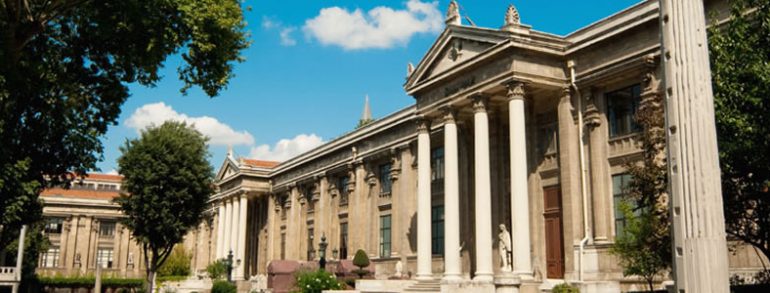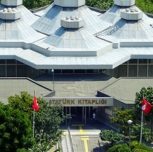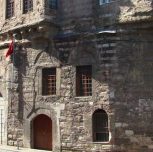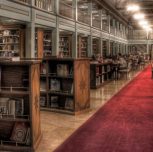Established in 1891 as the Müze-I Humayun [Imperial Museum], the Istanbul Archeology Museums are the leaders in the field of archeology science. Gathered and preserved by Fethi Ahmet Paşa, the Tophane-i Amire Musiri [Federal Marshal] in 1266 Hijri in the Aya Irini Church. The asar-i atika [old works] attract the attention of both domestic and foreign visitors. Upon the odd interest of the above-mentioned people on the war tools and gathering information on them, Harbiye Nezareti [Ministry of War] became anxious about it and vacated the old works from Aya Irini Church and transferred it to Cinili Mansion in Topkapi Palace. The first nizamname [ordinance], prepared on April 8, 1874 to safeguard the old works, was amended by Osman Hamdi Bey in 1822 in accordance with the conditions of those day with the claim for that nizamname privileging the foreigners more; and Sanayi-i Nefise Mektebi was built in 1883, what today is called as Eski Şark Eserleri Müzesi [Old Oriental Works Museum].
Continuing its words on enlisting how Muze-i Humayun was mentioned in the laws and regulations of Maarif Nezareti [Ministry of Education], Alpay has also stressed on the structuring of Istanbul Archeology Musem, which is comprised of three museums as above-mentioned, and on the works in them. As we learned from Alpay, a Tablet Archive, which preserves cuneiform writings, and the works of eastern origin nations like Assyria, Babylon, Egypt, Phoenicia, Hebrew and Hittite. The building or Archeology Museum exhibits works of Byzantine and Rome periods, works belonging to Christianity like sarcophagus; portraits and sculptures, medals, seals, coins and coin cabins of Islamic and non-Islamic origins, besides a library. In the Cinili Mansion, however, Islamic works are displayed. Along with that, there are manuscripts of Pashas. In other words, the Museum contains very significant and precious works, coming from various regions within the Ottoman Empire, from Balkans to Africa, from Anatolia and Mesopotamia to Arabian Peninsular. Since the period of Sultan Abdulmecid, in the period between 1840 and 1922, including the documents other than the archeological ones, several services of classification, cataloguing, inventory generation and research are made on the original documents of around 150,000 official correspondences; and, The Ottoman Archeological Documents Archive was established under the Directorate of Istanbul Archeology Museums. Drawing attention to the two PhD thesis realized from the archive documents, Alpay also mentions about infrastructural work on the classification and research operations in the Ottoman Archeological Documents Archive of Istanbul Archeology Museums.
After giving information on the history, structuring and reorganization of Istanbul Archeology Museums’ Archive, Alpay expresses the benefit of applying to the authorities for reopening of the archive to the readers and researches, which was closed to them as of 4 January 2005; and, he completed his speech by connecting this issue to the perception of the old works and pointed at the importance of remedying this fault by reopening the archive.
The library, which forms one section of the Istanbul Archeology Museums, is located in the Eminönü district of Istanbul. The library, together with the museum building, was built by the renowned architects of that period and by the professor of Sanayi-i Nefise Mekteb-i Alisi, the Architect Aleixandre Vallaury. In the new museum’s building, the façade of the antique works were paid special attention. It is said that the outer façade was inspired by Aglayan Kadinlar Lahdi [Crying Women Sacrophagous]. Spacious halls are allocated for the display and organization of the museum. The first part of the museum was opened in 1891, and ther other parts were opened in 1903 and 1907 with the permission of Sultan Abdülhamit II. The museum library is located next to the Treasure Room on the upper level and is called the Imperial Library.
One enters the two-storied library through a large hall, and it is decorated with wooden works from the floor to the ceiling. The library covers a space of roughly 500 square meters. The major part of the library houses the books of Osman Hamdi Bey, which were provided either by donation or by purchase. The number of manuscripts and printed works have increased to a very considerable number since its opening It contains the specialized works in the domains of scientific, archeology, the history of art, and history in several languages. Furthermore, there are very significant collections obtained through donations. The collections of Ahmet Cevat Paşa, Mehmet Şakir Paşa, Sultan Mehmet Resat V , Diyarbekirli Sait Paşa, Recaizade Ekrem, Murtaza Hocazade Hatice Hanim, Zeki Megamiz, Karaman Buyukkaya, and H. Turhan Daglioğlu are among the major collections held in the library.
Working in the library is subject to special permission which can be obtained from the Directorate of Istanbul Archeology Museums.






![Millet [National] Library](http://www.visitingistanbul.com/wp-content/uploads/2016/08/sadirvan_genis-153x152.jpg)



